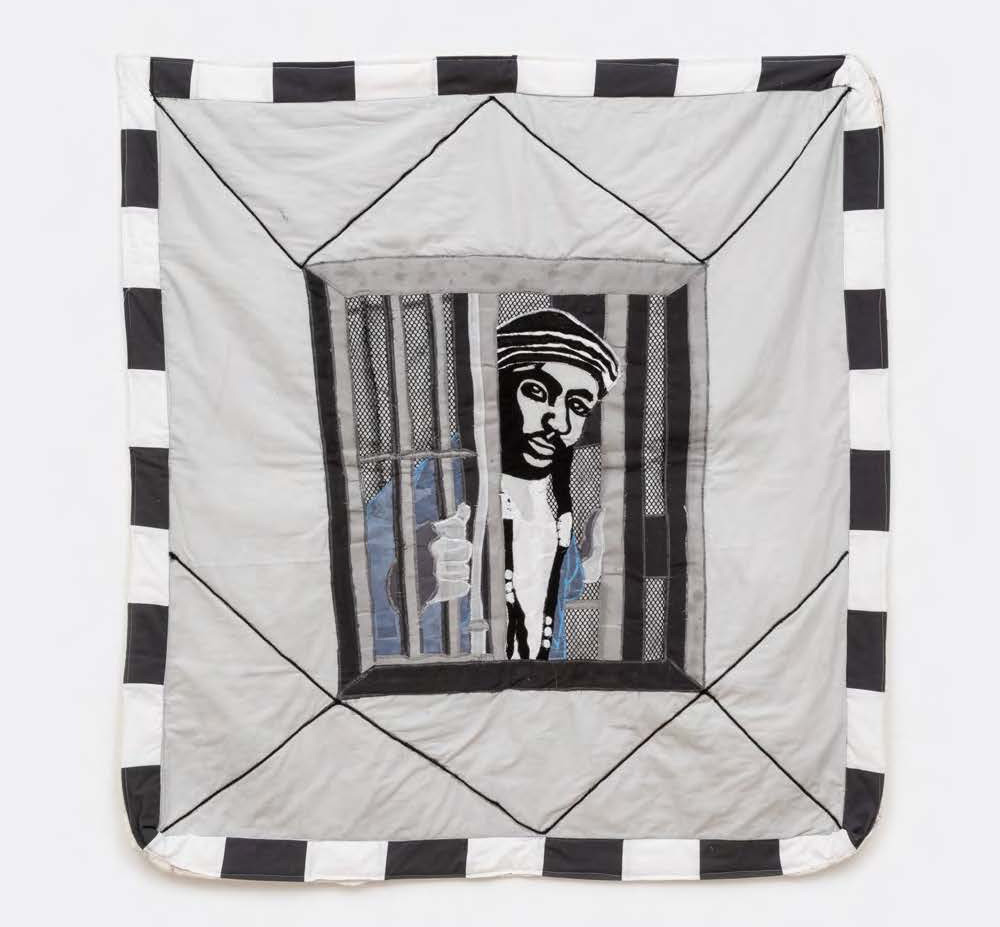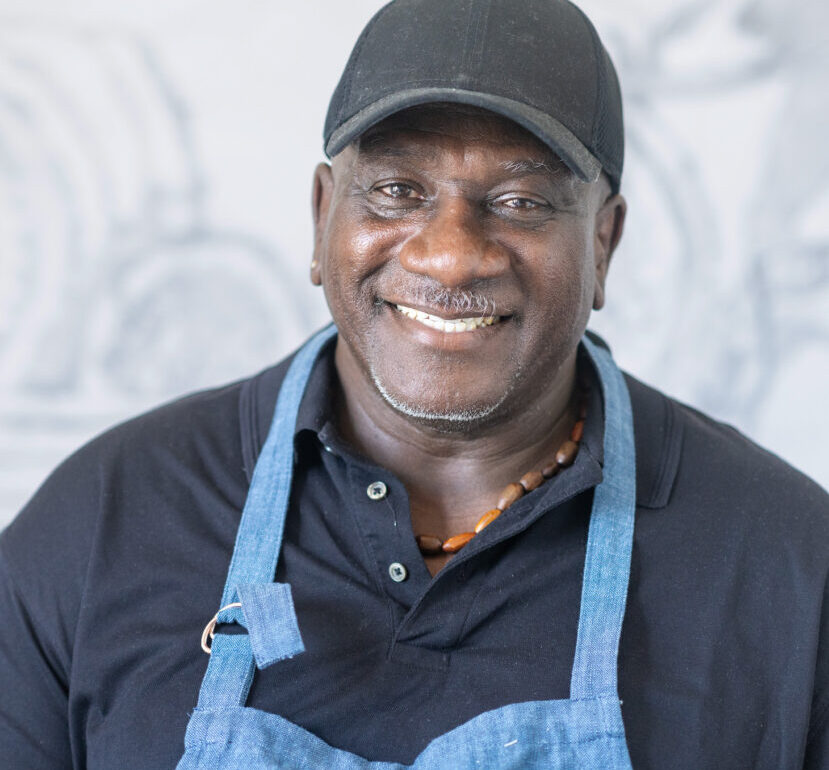Gary Tyler was just a teenager when he landed on death row, wrongfully imprisoned for murder, in 1974. And it would be four decades before he left Angola State Penitentiary in Louisiana behind, beginning a new life as an artist and sharing the reality of his prison experience in evocative works of quilting and appliqué.

Gary Tyler. Photo by Dorian Hill, courtesy of the artist and Library Street Collective.
Now 65, Tyler was awarded the 2024 Frieze Los Angeles Impact Prize for that textile work, which will be on display at this week’s Frieze Los Angeles art fair through March 3. At the heart of that work is the trauma he both suffered and witnessed in his fellow inmates in his years at the penitentiary. His pieces are largely self-portraits and scenes from prison, and are dedicated to broadening the understanding of what life there is like.
He ended up there as the result of a protest against integration and busing that erupted outside Destrehan High School, where he was a sophomore, in the small town of Destrehan, Louisiana. A 13-year-old white boy was shot and killed during the protest. And after Tyler, an African American, vocally defended a cousin who was being violently detained by state police, he was arrested, charged and ultimately convicted of the murder by an all-white jury when he was 16.
After the U.S. Supreme Court ruled that the state’s death penalty was unconstitutional, Tyler was ordered a new trial. He was recommended for parole three times by the Louisiana Board of Prisons, and became a national cause célèbre, covered by the New York Times and supported by Amnesty International. But he was denied each time. His attorneys finally landed an imperfect deal with Louisiana prosecutors: Tyler would be released if he pled guilty to manslaughter, a lesser charge with a penalty less than what he’d already served.
Tyler had embarked on a series of careers behind bars: He had learned graphic design, became a hospice volunteer to dying inmates, repaired wheelchairs and was president of the prison drama club for 28 years. He also learned to quilt, which became an outlet for his artistic expression that is now recognized around the art world. That artwork depicts his plight in fabric and understated colors: In one called “Defiant,” a prisoner stands with his wrists in chains, a look of grim pride on his face. Others show inmates laboring in a prison yard or peering between iron bars, with depictions of the occasional butterfly to represent freedom and transformation.
His Frieze Impact award comes with a $25,000 prize, given by the art fair in connection with Endeavor Impact and The Center for Art and Advocacy.
“I have no excuse to sit on this,” Tyler said, describing his mission as an artist. “I love doing traditional quilts, but I want to do something provocative. I want to do something that’s educational. I want to do something that’s enlightening to where people can really look and say, ‘Why?’”
This interview has been edited for clarity and brevity.
Capital & Main: When you were charged for the death of that boy, did you believe the truth would come out?
Gary Tyler: When you are a kid, you are very confused, because you simply got arrested for a nonlethal offense by protesting against the maltreatment of fellow students and yourself. I was a young person and confused [about] what was really happening. Of course, you think that it’s all gonna end. But in my case, it didn’t end until four decades later.
When you were convicted and sentenced, you were still a teenager?
I was a teenager. I was charged with first-degree murder, and I was convicted unanimously by an all-white jury. Automatically, I was given the death penalty. They set my execution date: May 1, 1976.

“Defiant” (1976, 2023) by Gary Tyler. Photo by Tim Johnson, courtesy of the artist and Library Street Collective.
When did you first think of yourself as an artist?
I had never thought of myself as an artist. When I was on death row, I noticed a guy making picture frames and jewelry boxes out of matchsticks and cigarette packs. I wanted to know how to do that, so the guy showed me. But I never thought that this would be a manifestation of my life later on. In prison, an artist is considered a hobby crafter … [who] earns a living by selling their artwork to the public and makes gifts for their families. They never look at themselves as artists.
But as I talk to people and they tell me, “Hey, Gary, you have a gift, and you were quite good at it when you were in prison. You can rank yourself as being an artist.” Reflecting on that, I agreed that I’m not a hobby crafter. I am an artist.
We recently did an article about a program called Jail Guitar Doors, which brings musical instruments and instruction into prisons. It seems that having a creative outlet can be crucial to someone in prison.
It also helps people to recognize latent talent, something that they never thought they had. I met guys that never thought that they could sing learn how to sing — guys learning how to play a guitar, a bass guitar and drums. Unfortunately, they wound up in a situation where they realized that, hey, I had something that probably could have been discovered earlier in life — before this terrible tragedy happened in their lives.
You chose to tell the story of your life through your artwork?
Yeah. And also the lives of others. The people that I befriended, people who have died in prison while I was there. People who I have taken care of as a hospice volunteer that have died. To show the humanity of prison life.
What was it about quilting that appealed to you?
Well, nothing, to be honest with you. [laughs] I thought it wasn’t a manly thing to be doing in prison, but being a hospice volunteer — prisoners wanted to know what we could do to financially support the program: “Let’s start making quilts to sell to the public.” And guys started making quilts. They asked me to help them out because they were falling behind.
Since I am a certified graphic artist, I learned a technique called appliqué, and I started applying that process into quilting. That’s where my imagery came about, and lo and behold, it was something that got many people’s attention.

“One of World’s Wonders: African Giant Swallowtail Butterfly” (2023) by Gary Tyler. Photo by Tim Johnson, courtesy of the artist and Library Street Collective.
What do people not realize about life in prison?
Sometimes you have these movies that give a false depiction about prison life. Prison is a world of its own. It is composed of people from all walks of life: The good, the bad and the ugly, but sometimes, people in prison are not what society depicts them to be. You have genuinely good people in prison despite the crime that they went to prison for. Everybody in prison is not a criminal just because a person committed a crime. There are people in prison that deserve a second chance.
What’s the most important thing to know about living on death row?
I don’t think any [inmate] can accept that someone wants to take their life from them. It was an uneasy feeling. It was surreal that this was happening. It was a whole lot for a young person my age. It took me some time to really grasp what was taking place. It was a living hell, to be honest with you.
Were there many others there who were also not guilty of what they were convicted of?
You can pick up the papers every day — well, not every day — and you see people who have been exonerated for crimes they didn’t commit 20, 30, 40, 50 years ago. It is just horrible how the criminal justice system operates.

“Unwavering” (1988/1989, 2023) by Gary Tyler. Photo by Tim Johnson, courtesy of the artist and Library Street Collective.
When you were finally released, were you able to use quilting right away to make a living?
No, when I got out, I had to restart my life all over. When I went to prison at 16 years old, I was a juvenile. I lived under the auspices of my parents, who paid the bills, who took care of me as their child. Now I no longer have them. I exited prison an elderly man. I was 57 years old, and then I found out that I’d have to work 10 years to even start receiving Social Security. All this time I’m thinking that if you reach a certain age, you automatically get Social Security. That’s if you worked in the system, had a job in life. But I was in prison all that time. Now I got to work 10 years to put something in.
That’s a tall order.
I’ll be 77 years old before I’m able to start drawing Social Security. So I had to concentrate on reacclimating, adjusting to life and doing the things that will give me a solid foundation that will help me sustain a living — a life out here in the free world.
People who knew me and the kind of artwork that I did, like quilting and drama, always reminded me, “Gary, people would appreciate your artwork more being out here than when you were in prison.” I was working to really get an anchor, get my life established. I got a studio and people heard about me, my artwork, and knew that I was a quilter. And miraculously, that was like a clarion call: I started getting fabric from people all over. People donated sewing machines.
What does it mean to you that the art world is paying attention to what you’re saying?
If my artwork is able to give people an understanding of what an individual goes through while in prison — that a person can be just as creative, can be just as productive than those who are not incarcerated, and come out somewhat normal and able to function — it definitely means a lot.
Since I am in the position that I am, I hope that it’s a reflection of the men and women in prison, that you don’t cease to be a human being while you’re in prison. You can be just as productive. You can be just as meaningful.
Copyright 2024 Capital & Main
This post was originally published on this site be sure to check out more of their content.







